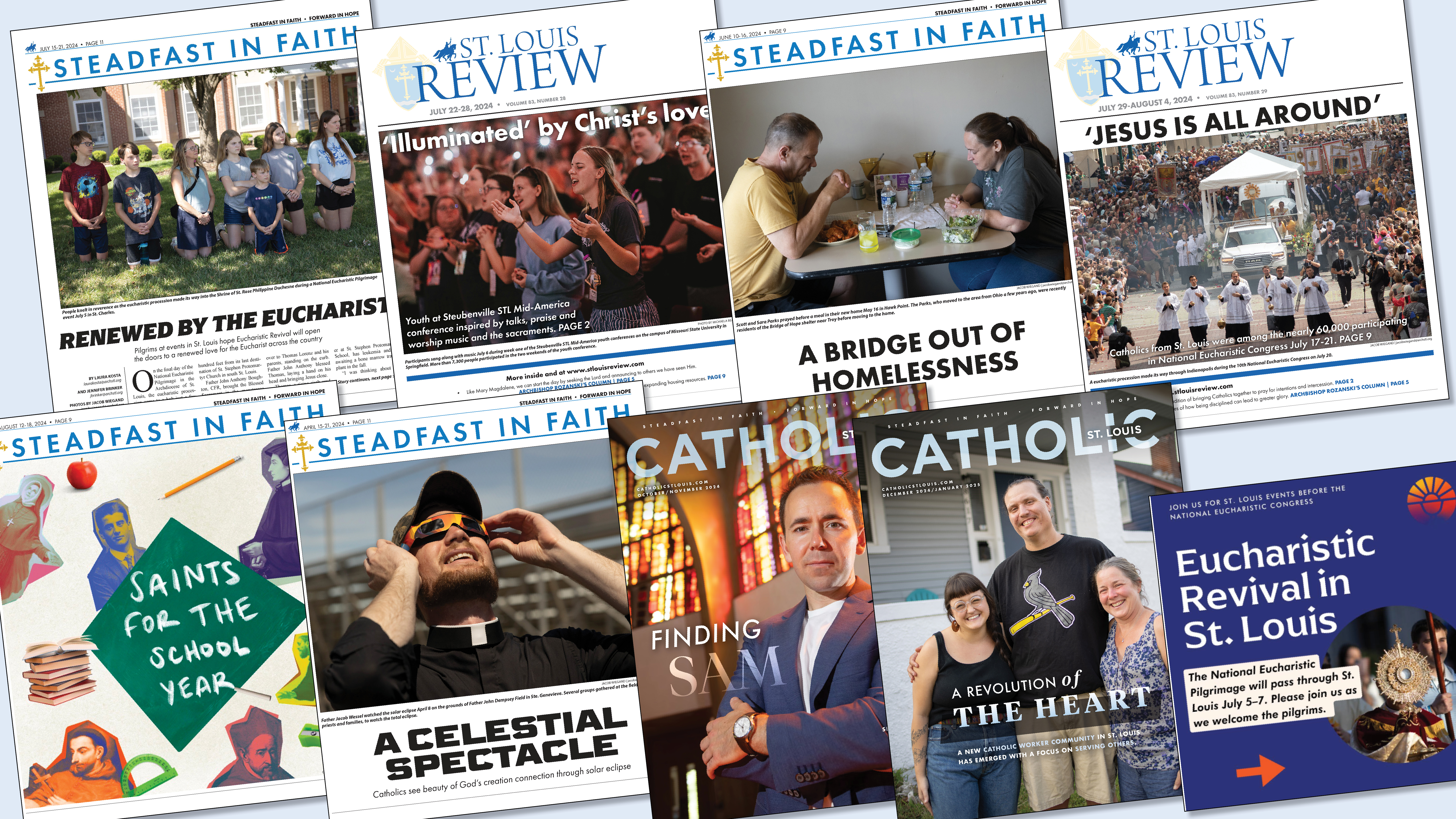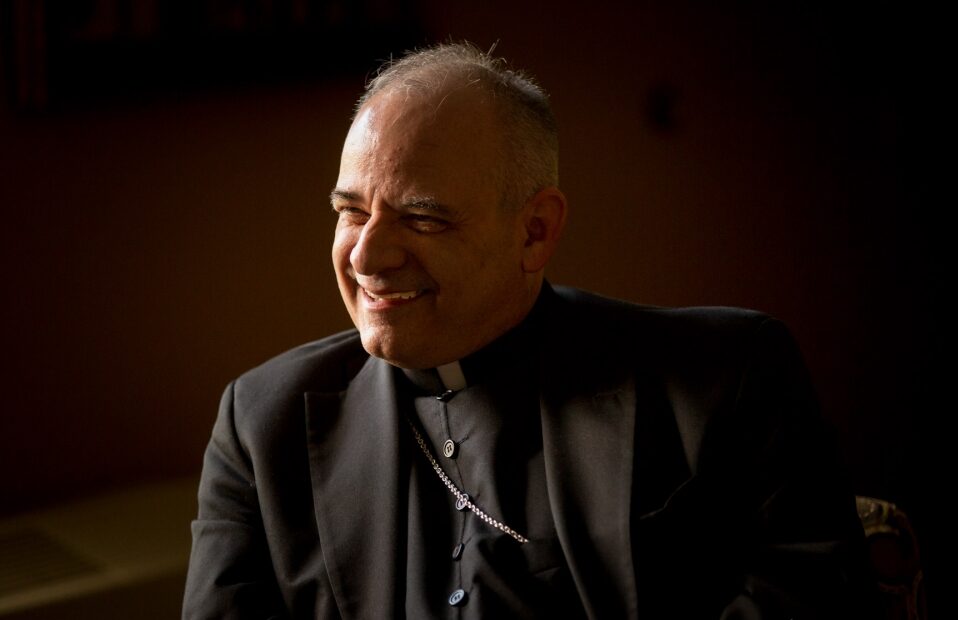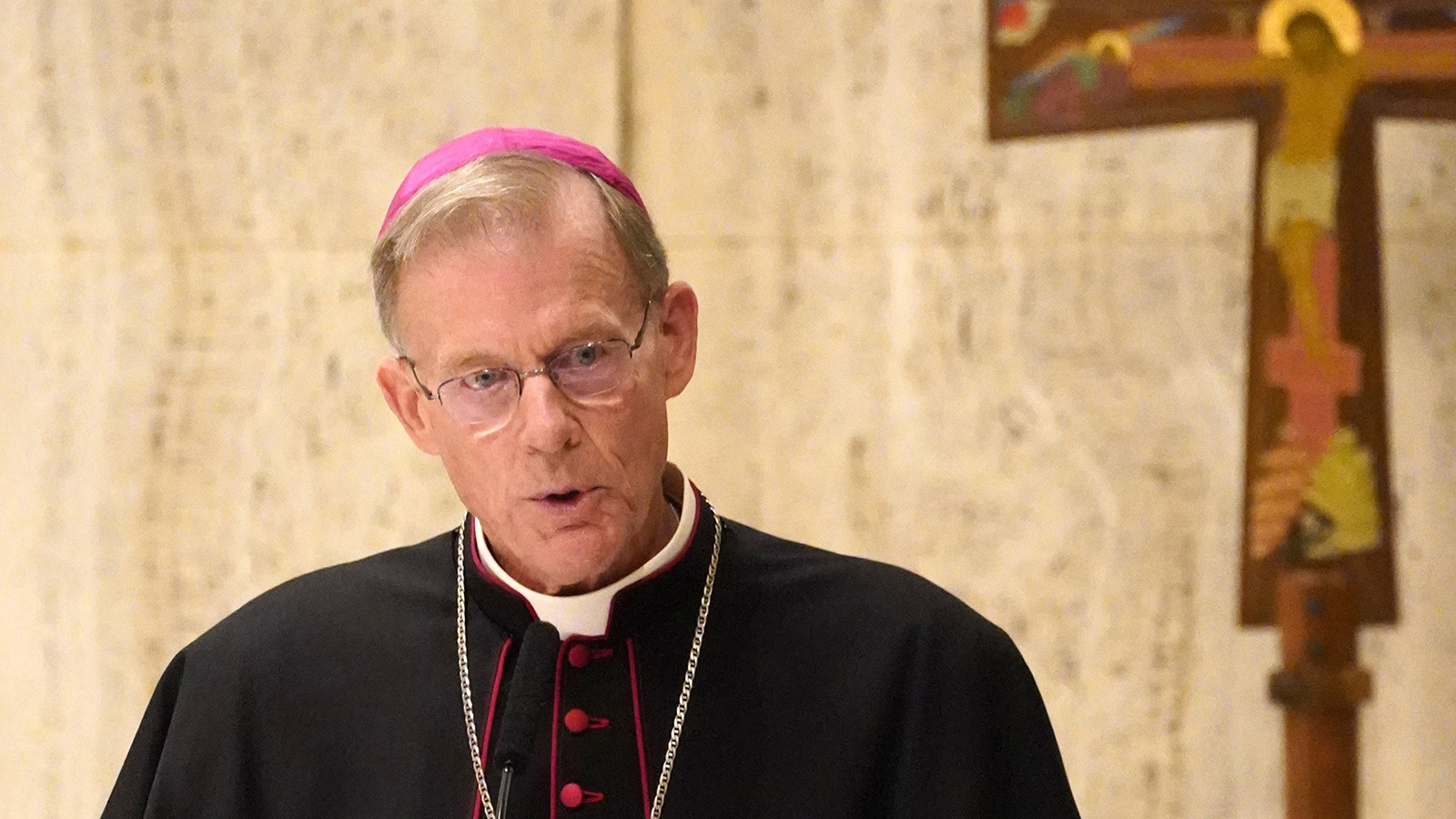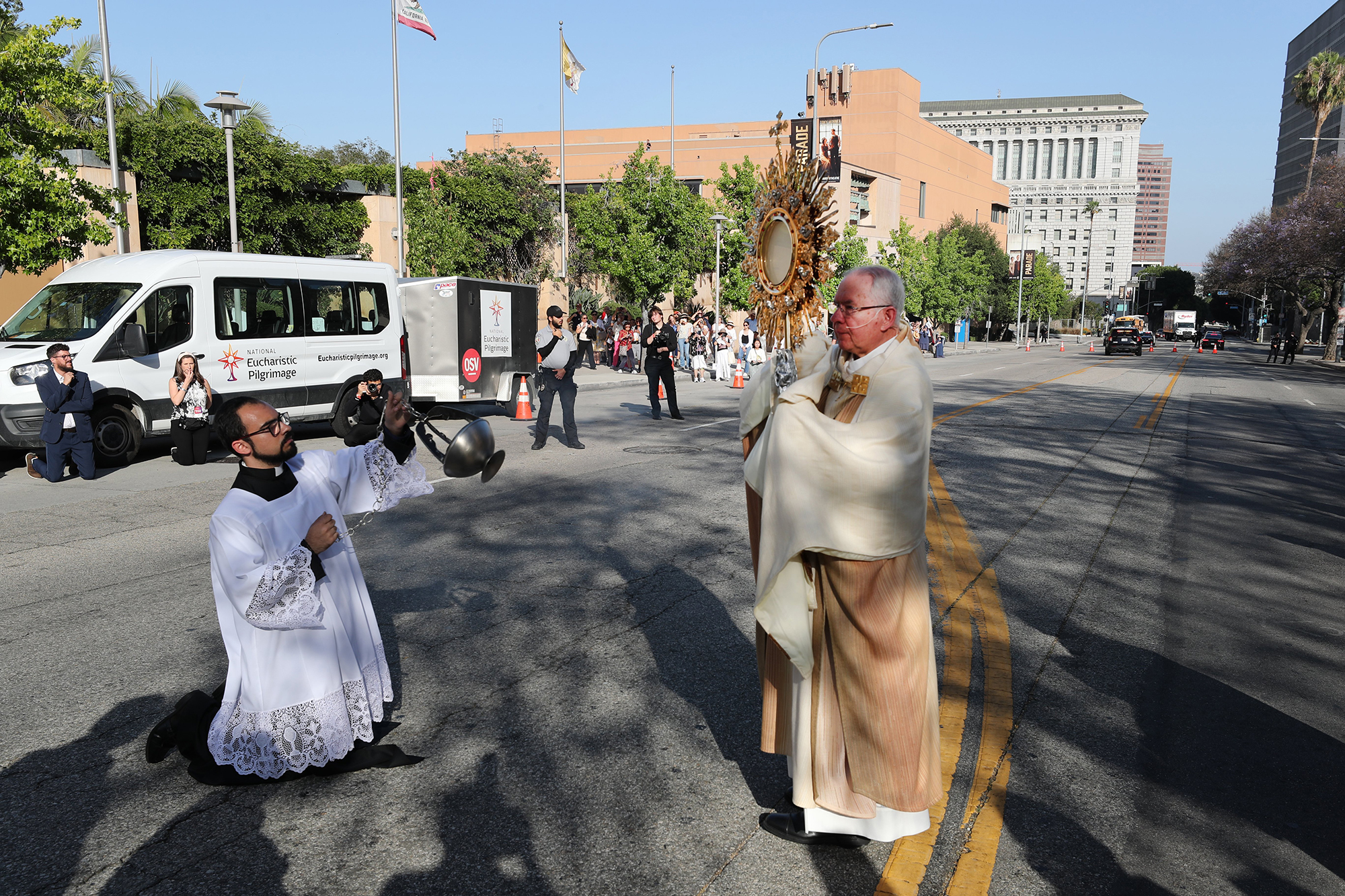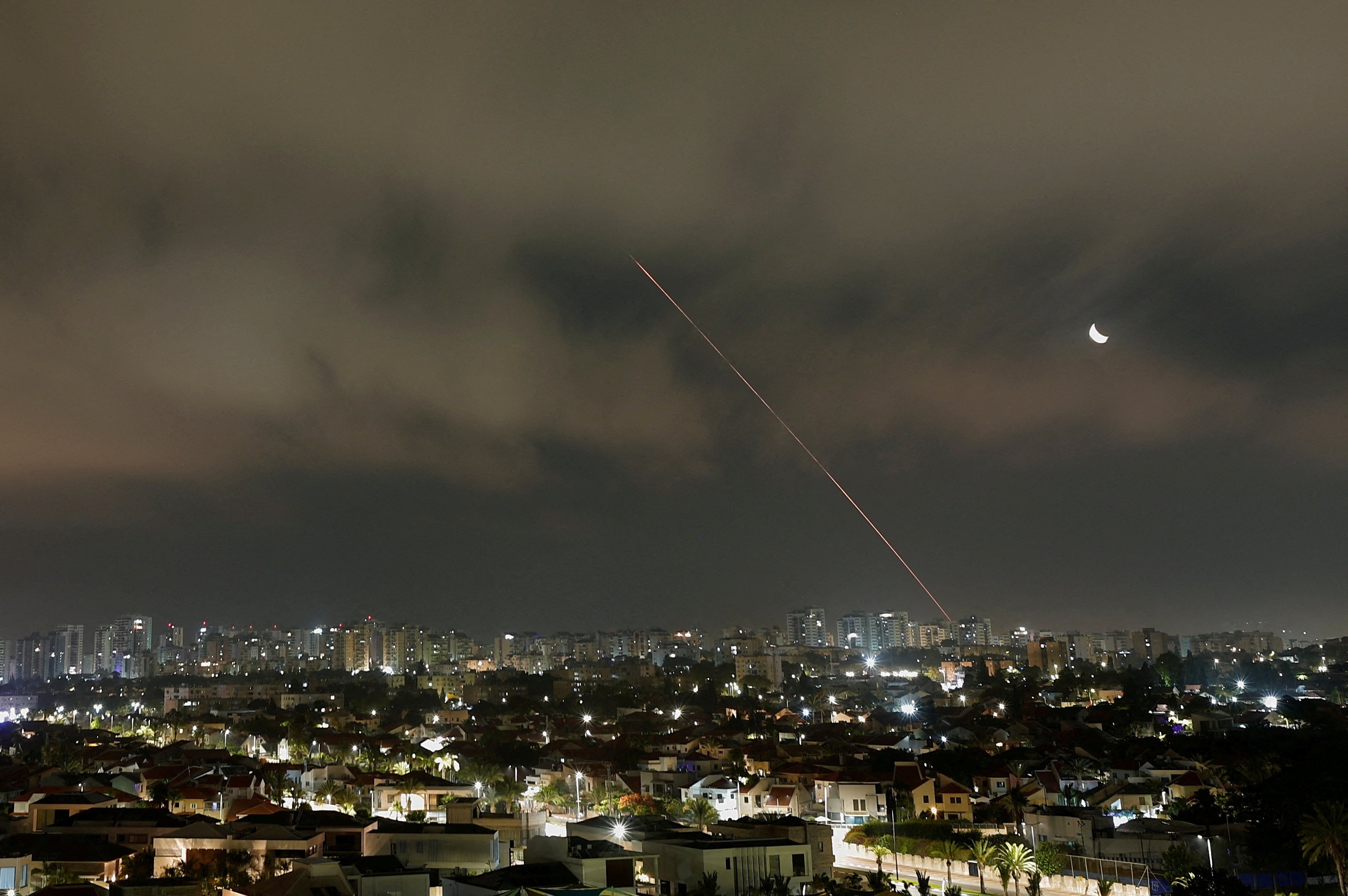Pope Francis dies April 21 at age 88
Archbishop Mitchell T. Rozanski will celebrate Mass for Pope Francis at the Cathedral Basilica of Saint Louis at noon on April 21
VATICAN CITY — Pope Francis, history’s first pope from the global south, died April 21 after fighting pulmonary disease for the last few months.
Jorge Mario Bergoglio was born in Buenos Aires, Argentina’s capital city, Dec. 17, 1936. His father was an immigrant from northwestern Italy and his mother an Argentine of Italian origin. He was especially close to his paternal grandmother, whom he later credited with inspiring his “journey of faith.”
As a teenager, the future pope swept floors in a factory, ran tests in a chemical laboratory and worked as a bouncer in a bar. When he was 21, he suffered a severe infection, and doctors removed the upper half of his right lung.
He earned a chemical technician’s diploma from his high school and entered the Jesuit novitiate in March 1958. After studying liberal arts in Santiago, Chile, he returned to Argentina and earned his licentiate in philosophy from the Colegio San Jose in San Miguel. Between 1964 and 1965, he was a teacher of literature and psychology at Inmaculada high school in the province of Santa Fe, and, in 1966, he taught the same courses at the prestigious Colegio del Salvador in Buenos Aires.

Pope Francis appeared on the central balcony of St. Peter’s Basilica to deliver his Easter blessing “urbi et orbi” (to the city and the world) at the Vatican April 20. The pope died the next morning, April 21.
In 1967, he returned to his theological studies and was ordained a priest Dec. 13, 1969. He later recounted that he wanted to serve as a missionary in Japan, but that his superiors refused because of his medical history.
After his perpetual profession as a Jesuit in 1973, he became master of novices at the Seminary of Villa Barilari in San Miguel. Later that same year, he was appointed superior of the Jesuit province of Argentina, a role in which by his own account he proved a divisive figure.
“I was only 36 years old. That was crazy. I had to deal with difficult situations, and I made my decisions abruptly and by myself,” he recalled four decades later, in an interview as pope. “My authoritarian and quick manner of making decisions led me to have serious problems and to be accused of being ultraconservative.”
After his term as provincial, he returned to San Miguel as a teacher at the Jesuit school, a job rarely taken by a former provincial superior. In 1986, following a few months of study in Germany, he was sent to serve as spiritual director to Jesuits in the central Argentine city of Cordoba, where he went through what he later called a “time of great interior crisis.”
In May 1992, Father Bergoglio was called back to Buenos Aires to serve as one of the archdiocese’s three auxiliary bishops. He kept a low profile in the job, spending most of his time in ministry at the local Catholic university, counseling priests and preaching and hearing confessions.
He was named coadjutor archbishop in 1997 and became archbishop of Buenos Aires in 1998; Pope John Paul II named him to the College of Cardinals three years later.
As leader of an archdiocese with more than 2.5 million Catholics, Cardinal Bergoglio strove to be close to the people. He rode the bus, visited the poor, lived in a simple apartment and cooked his own meals. Many of his flock continued to refer to their cardinal-archbishop as “Father Jorge.”
As cardinal, he was one of the presidents of the 2001 Synod of Bishops, which focused on the role of bishops in the church, and was elected to the synod council, bringing him to the attention of fellow bishops around the world.
His international reputation was enhanced by his work at the 2007 assembly of the Latin American bishops’ council, CELAM, and particularly by his role as head of the committee that drafted the gathering’s final document on reforming and reinvigorating the church’s evangelizing efforts on the continent.
His election to pope on March 13, 2013, came on the second day of the conclave, on its fifth ballot, a surprisingly quick conclusion to an election that apparently had begun with no clear favorite.
He was the first pope in history to come from the Southern Hemisphere and the first non-European elected in almost 1,300 years. The Jesuit was also the first member of his order to be elected pope and the first member of any religious order elected in nearly two centuries.
God’s mercy was a constant theme in his preaching and was so central to his vision of what the Church’s ministry must embody that he led an extraordinary Holy Year of Mercy in 2015-16.
He spent much of the first nine years of his pontificate pursuing two ambitious projects: revitalizing the Church’s efforts at evangelization — constantly urging outreach rather than a preoccupation with internal Church affairs — and reforming the central administration of the Vatican, emphasizing its role of assisting bishops around the world rather than dictating policy to them.
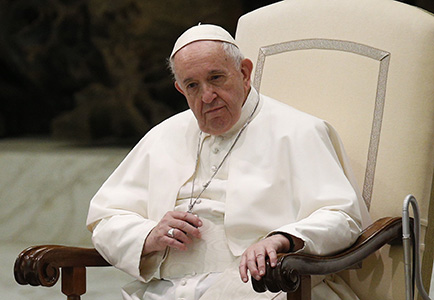
Pope Francis, formally Argentine Cardinal Jorge Mario Bergoglio, died April 21, 2025, at age 88.
Pope Francis’ focus on the pastoral aspect of his ministry, and the ministry of all priests, led him to shed elements of protocol and even safety concerns that would have distanced him from crowds at his public appearances; he kissed thousands of babies, drank the popular Argentine mate herbal tea whenever anyone in the crowd offered it, and tenderly embraced people with disabling or disfiguring ailments.
In the first years of his pontificate, he invited small groups of Catholics — beginning with the Vatican gardeners and garbage collectors — to join him for his early morning Mass in the chapel of his residence, and his short homilies quickly became a primary vehicle for his teaching. With an average congregation of fewer than 50 people, the intimate setting gave the pope the space to minister simply and directly, as most of the world’s priests do.
‘Dedicated to the service of the Lord and His Church’
U.S. Cardinal Kevin J. Farrell, the “camerlengo” or chamberlain of the Holy Roman Church, announced to the world that Pope Francis had died April 21 at the age of 88.
Shortly before 10 a.m. in Rome, Vatican Media’s livestream of St. Peter’s Square switched over to a live broadcast from the chapel of the Domus Sanctae Marthae where the pope lived.
Standing at a microphone and taking his cue that the camera was rolling, Cardinal Farrell gave the announcement in Italian: “Dear brothers and sisters, with deep sorrow I announce the death of our Holy Father Francis.”
“At 7:35 this morning Francis, the Bishop of Rome, returned to the house of the Father. His whole life was dedicated to the service of the Lord and His Church,” said the cardinal, who was flanked by Cardinal Pietro Parolin, Vatican secretary of state, and Archbishop Edgar Peña Parra, the substitute for general affairs in the Secretariat of State. Standing next to the archbishop was the master of liturgical ceremonies, Archbishop Diego Ravelli.
Cardinal Farrell said that the pope “taught us to live the values of the Gospel with fidelity, courage and universal love, especially in favor of the poorest and most marginalized.”
“With immense gratitude for his example as a true disciple of the Lord Jesus, we commend the soul of Pope Francis to the infinite merciful love of the Triune God,” he said.
Later in the morning, local churches started tolling the death knell from their bell towers. The request had come from Cardinal Matteo Zuppi, president of the Italian bishops’ conference, who had shared the announcement of the pope’s death on the conference website.
He asked all churches across Italy to ring the solemn toll throughout the day as a sign of mourning and to promote moments of personal and communal prayer in union with the other churches in Italy and with the universal Church.
The Monday after Easter, April 21, is a major holiday in Italy with many residents going to the countryside for picnics or meals with friends and families. Rome, however, was full of tourists who were taking advantage of the holidays and time off from work and school.
Funeral rites to begin April 21
Pope’s funeral rites, a celebration of hope, to begin late April 21
Pope Francis’ funeral rites, like those for any pope or any Christian, are meant to “reinforce the hope and witness to the faith” that those who have been baptized in Christ “will rise with him to new life.”
The prayer rituals for the formal recognition of his death April 21, his funeral and eight memorial Mass are designed as moments not of mourning but of prayers for his eternal rest in heaven and for the church.
The rites and rituals used are published in the “Ordo Exsequiarum Romani Pontificis” (“Funeral Rites of the Roman Pontiff”). The rites originally were approved by St. John Paul II in 1998 but were released only when he died in 2005. Modified versions of the rites were used after Pope Benedict XVI died Dec. 31, 2022.
The rites are divided into three “stations” based on the place they occur: “at home, in the Vatican basilica and at the burial place.”
Even the moment of the formal verification of the pope’s death takes place in the context of a prayer service “at home” in the chapel of the Domus Sanctae Marthae where he lived. The Vatican said that ritual would take place at 8 p.m. Rome time April 21.
The ritual book has separate services for transferring the body to St. Peter’s Basilica, the funeral, the burial and the memorial Masses that follow the funeral for the next eight days.
As revised by Pope Francis, the new rites maintain the practice of having the deceased pope’s body placed in St. Peter’s Basilica for public viewing and prayer before the funeral.
In his autobiography, released in January (2025), Pope Francis said, “I will not be buried in St. Peter’s but at St. Mary Major. The Vatican is the home of my last service, not my eternal home.”
Reactions to the pope’s death
Archbishop Mitchell T. Rozanski will celebrate Mass for Pope Francis at the Cathedral Basilica of Saint Louis at noon on April 21.
Archbishop Rozanski issued a statement April 21 on the death of Pope Francis. “We now commend to God the soul of Pope Francis and give thanks for the great gift that he has been to the Church, particularly over these past 12 years. Pope Francis’ service as a Jesuit priest, then bishop and Archbishop of Buenos Aires, and his election as our Holy Father has been marked by great humility. His unceasing concern for the poor demonstrated to us how we may live out of the Gospel in our world.
In the words of his encyclical “Evangelii Gaudium” (“The Joy of the Gospel)”, “the Church which ‘goes forth’ is a community of missionary disciples who take the first step, who bear fruit and rejoice.” As shepherd of the universal Church, Pope Francis lived these words until his passing into eternity.
May Pope Francis, who labored in the Lord’s vineyard here on earth, now know the fullness of peace promised to us by our Savior, Jesus Christ! Let us pray to the Heavenly Father that eternal rest may be granted unto him.”
Archbishop Timothy P. Broglio, president of the U.S. Conference of Catholic Bishops, issued a statement in remembrance of the pope.
“Pope Francis will long be remembered for his outreach to those on the margins of the Church and of society,” Archbishop Broglio stated. “He renewed for us the mission to bring the Gospel out to the ends of the earth and offer divine mercy to all. He has also taken advantage of the present Jubilee to call us to a profound hope: one that is not an empty or naïve hope, but one grounded in the promise of Almighty God to be with us always.”
“The Bishops of the United States unite in prayer with Catholics here and around the world and all people of good will in gratitude for the life of our revered shepherd,” he said. “We mourn the passing of our Holy Father and beg Saint Joseph to accompany him. Eternal rest grant unto him O Lord.”
Standing in New York’s St. Patrick’s Cathedral, where a portrait of Pope Francis was flanked by lit candles alongside an empty chair draped with purple and white stoles, Cardinal Timothy P. Dolan of New York shared informal reflections on Pope Francis during a morning Mass.
“Beyond the sorrow, the sadness that we feel at the passing of our Holy Father, Pope Francis, we express our faith in the resurrection of Jesus,” he said before the Mass’ opening prayer. In his homily, he called attention to Pope Francis’ last public words being his Easter blessing.
“Yes we are sad, but we are filled with Easter joy,” Cardinal Dolan said. “When we believers are kind of a little lost and don’t know quite what to do, we always rely on prayer. Here we are, this second day of Easter, this Easter Monday, hearing the news of our Holy Father passing over. Here we are at the greatest prayer of all, the Holy Sacrifice of the Mass, which we offer, asking the Lord’s mercy on his immortal soul, thanking God for the gift that he was to us, and asking for consolation upon God’s family.”
